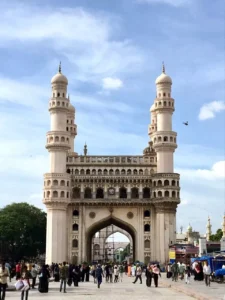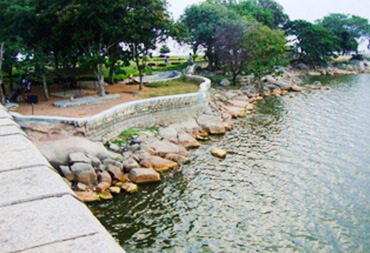
Charminar
The Monument of Eternal Beauty Suggestive of Hyderabad
History and cultural heritage are always associated with India. Among numerous monuments standing tall in the heart of Hyderabad, representing the city, is Charminar. The imposing structure is more than 400 years old and continues to draw interest not only among tourists but among historians and architects who feel the essence of a vibrant past which got formed into the Mughal architectural grandeur of the city. It is hard not to be blind to this architectural monument concerning history and culture, both as a tourist or a resident.

The Problem: Urbanization and Environmental Stress
Charminar The Monument Charminar was built in 1591 by the ruler of Hyderabad at that time. It is Sultan Muhammad Quli Qutb Shah who built the monument in the form of a symbol to mark the end of a devastating plague in the region. The monument soon became the turning point in the growth of the city. With time, Hyderabad expanded all around the Charminar, and the pristine symbol of royal architecture now finds itself in the middle of a busy, chaotic urban landscape.
The primary reason is that Charminar, a monument which was once surrounded by open spaces and wide streets, is now caught up in crowded bazaars, heavy traffic, and heavy pollution. All these factors have resulted in a decline in the integrity of the structure and are rising increasingly over its long-term preservation. Urbanization has brought several challenges:
Structural Degradation: Pollution and environmental stress have been responsible for the degradation of the limestone and granite constituting Charminar. The dust from adjacent market places, vehicular smoke, and acid rains have all contributed to the wear and tear faced by the facade of the monument.
Traffic Congestion: Three of the most crowded roads in Hyderabad run parallel to Charminar. Pollutants in the air, apart from the usual emanating from vehicles, flow through the monument itself and keep eroding its foundations.
Commercial Infiltration: Even the Laad Bazaar-a once-famous market-and several more smaller markets have, in this process, crept into the periphery of Charminar. This severely restricts space for visitors to appreciate the monument and increases the possibility of uncontrolled activities that may affect the structure.
Case Study:

Charminar and the Crack of 2012
In 2012, a huge crack became visible in the southeastern minaret of Charminar, which made a ripple effect among historians, locals, and government authorities. Experts attributed it to the vibrations caused by heavy traffic and other construction activities in the area. The Archaeological Survey of India immediately responded with a critical assessment of the situation and thus brought forth concern regarding the long-term safety of the monument.
This incident has shown the fragile condition of Charminar, and the government was forced to take steps seriously for the preservation of the monument. However, the crack is a sign that unless drastic measures are implemented strictly, this deterioration of the treasure may get accelerated.
The Stirring Problem: Loss of Cultural Assets
Urbanization and pollution have already been threatening the physical structure of Charminar, but the cultural part is also being strained with these issues. With every brick of modernity placed in the city and the commercial activities that are going around this monument, the glorious historical essence of the place seems to be fading away from this heritage. Some of the major issues that are further agitating the problem are as follows:
Commercial Appropriation: Sellers and shopkeepers, who operate close to Charminar, use it as a marketplace to vend their wares. While this doesn’t seem too serious, one should consider that these activities are unmanaged, and the consequence is littering, graffiti, and overall abandonment around and inside the building.
Tourist Experience: Charminar is actually a place of historical reflection, but chaotic experiences surrounding it kill all the vibes. The beauty of the monument’s architecture fails to get enjoyed because of the noise, overcrowding, and a lack of adequate facilities by the tourists.
Cultural Dilution: Charminar is no monument. It represents Hyderabad and the remains of Mughal glory interwoven with both Islamic as well as Hindu influences. The cultural value is diffused by the exigencies of commercial interests when these deeper assumptions are undermined by superficial tourist traps and badly managed activities.
Public Apathy: Most Hyderabadis know what is happening to Charminar, but the kind of resignation seen in them has helped nudge people into it, making it hard to raise collective action for the preservation of the monument.

Restoring Glory to Charminar
While the problems that face Charminar are great, solutions do exist that can both preserve the monument and improve the environment around it. Here’s what to do to protect Charminar for generations:
1. Strict Traffic Rules
The first step to preserve Charminar is to limit traffic. In 2019, the Hyderabad Traffic Police imposed traffic restrictions on Charminar. It has restricted traffic to only pedestrians within a radius of 200 meters from Charminar. This reduced pollution and vibrations by the vehicles, and it is a good example on how town planning can go a long way in protecting historical sites. However, more stringent measures like permanently declaring this area a no-vehicle zone and enhancing public transportation options need to be enforced.
2. Restoration Projects
In the case of such a structure, the Archaeological Survey of India has already undertaken several restoration projects, including cleaning, repairing, and fortifying this structure. In these regards, it is necessary to have continuous investment in these activities. However, restoration should not only be carried out by local artisans who are experienced in traditional construction methods but also ensured that repairs are done according to the original design of the monument.
3. Digital Documentation and Monitoring
Since the vulnerability of Charminar is evident, its monument status can be developed digitally so as to track any changes within the structure. Technologies such as 3D scanning and drone-based surveillance will capture minute details about how environmental factors affect the monument and therefore facilitate quick and precise intervention.
4. Public Awareness Campaigns
Taking the locals into the preservation process will greatly contribute to how their heritage site turns out in the long run. Public awareness programs that target the importance of Charminar and the plight of neglect can help generate support in the locality. The involvement and education of local schools, community groups, and tourist streams about heritage preservation can easily be emphasized upon.

5. Sustainable Tourism Development
Thousands of tourists come each year to Charminar; this is a good tourism force for preservation, but only if managed effectively. This can be done by demarcating zones that can be declared as a tourist zone with proper developed facilities with appropriate sign boards and guided tours comprising history and architectural designs that may help to beautify the visitor’s experience as well as contribute towards monument preservation through the tourism dollar.
6. Control of Commercial Activities
Heritage Zones have to be created where only certain vendors are permitted. It will help preserve the historical and cultural ambiance of the monument. Local authorities can collaborate with shop owners to ensure their activities do not hinder preservation efforts.
Factual Insights:
Charminar as a Cultural Center
The Ministry of Tourism has cited that the place has placed it in the list of the top 10 historical places visited in the country, with an estimated 1.5 million people visiting here every year. This only goes to show that this monument has its significance beyond being a culture heritage site but also an important place that acts as a driver for regional tourism and business activities.
This includes initiatives such as 2021 initiatives aimed at reducing traffic congestion and pollution around Charminar launched with several NGOs by the HMDA. Preliminary reports suggest that levels of air pollution around the monument have reduced by 15% since the inception of the project.
The Indian National Trust for Art and Cultural Heritage, or INTACH, Heritage Conservation Reports state that the environmental degradation along with the encroachment of the urbanization environment puts the monument as well as heritage into a more dangerous list; yet, INTACH association with the local authorities has been making amendments in small proportions in the past, such as pedestrianizing streets nearby, or razing illegal structures.
What You Can Do to Help
Preserving a monument like Charminar requires collective efforts. This is how you can contribute:
Respect the Monument: While visiting Charminar, do not litter or create anything which could adversely affect the structure. Treat the monument with the respect that it deserves.
Use Public Transport: In case you plan to visit, try using public transport instead of personal vehicles as this will help avoid traffic congestion and pollution around the site.
Spread Awareness: Tell your friends and family how Charminar can be preserved. This helps in creating more waves of protection and respect for the monument.
Support restoration: Contributing to NGOs working on heritage conservation is very helpful. Volunteer or donate to causes that aim at protecting and restoring Charminar.
Engage with Local Authorities: If you stay in Hyderabad, engage with local officials regarding preservation of Charminar. Public can really be quite crucial in the actions that are taken by government bodies within a shorter time frame.
Charminar’s Future Depended on Us
Charminar is more than a monument; it stands for the rich history and cultural diversity that Hyderabad represents. However, urbanization, pollution, and lack of awareness have slowly eroded this priceless heritage. Of course, these issues are very clear, but the solutions have now entered the realm of easy access. After all, effective restoration projects, responsible tourism, and public engagement can all help to ensure that Charminar will stand tall for centuries yet to come.
Not only is this a matter of preserving a building; there’s something deeper – the issue is that Charminar could actually save the relationship with our past for all of us.


